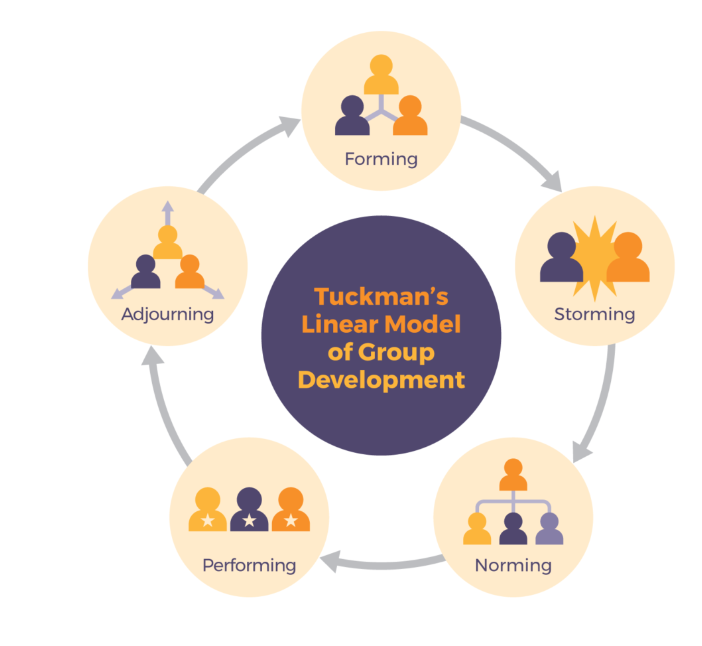26 Theories of Group Development and Functioning
Alexandria Lewis

Content Outline, Competency, and KSAs
I. Human Development, Diversity, and Behavior in the Environment
IA. Human Growth and Development
KSAs: Theories of group development and functioning
III. Interventions with Clients/Client Systems
IIIA. Intervention Processes and Techniques for Use Across Systems
KSA: Group work techniques and approaches (e.g., developing and managing group processes and cohesion)
Overview
Hepworth et al. (2023) defined a social work group “as three or more people with a common goal, shared beliefs (e.g., values or beliefs that distinguish group members from those outside the group), and interdependence, e.g., members work together to achieve their common goal (p. 217).
Several types of groups:
- Self-help groups
- Task groups
- Therapeutic/treatment groups
Note: The following is an accordion. Click on the terms to expand the content.
Treatment Groups
There are several types of treatment groups subtypes (e.g., support groups, educational groups, growth groups, therapy groups, socialization groups).
Examples :
- Psychoeducational Groups:
- Focus on providing information and education about specific issues (e.g., mental health disorders, substance abuse) to group members.
- Aim to empower members through knowledge, improving coping strategies and problem-solving skills.
- Support Groups:
- Offer emotional support and understanding among members facing similar life situations or challenges (e.g., grief, chronic illness).
- Foster a sense of community and belonging, helping members feel less isolated in their struggles.
- Therapy Groups:
- Conducted by trained therapists, these groups target the psychological and emotional needs of members, using various therapeutic approaches.
- Can be general (addressing a range of issues) or specific (focusing on particular disorders or problems).
- Skill Development Groups:
- Aim to teach and develop specific life skills or coping mechanisms (e.g., social skills, anger management, stress management).
- Provide a safe environment for practice and feedback, enhancing personal growth and effectiveness in daily living.
- Interpersonal Therapy Groups:
- Focus on improving interpersonal relationships and social functioning.
- Members explore their relationships, communication styles, and behaviors within the group dynamic, facilitating insights and changes.
Each type of treatment group addresses different needs and utilizes unique approaches, offering members tailored support and interventions for their specific challenges.
Forming and starting a treatment group involves several key steps to ensure its success and effectiveness:
- Identifying the Purpose and Objectives: Clearly define the goals and therapeutic focus of the group, such as addressing anxiety, depression, or developing specific skills.
- Determining Group Logistics: Decide on the size, open or closed membership, frequency and duration of meetings, and location.
- Developing Group Policies and Procedures: Establish rules and guidelines regarding confidentiality, attendance, participation, and how conflicts will be managed.
- Selecting Group Members: Screen potential members to ensure they are appropriate for the group’s focus and goals. Consider dynamics such as diversity, compatibility, and potential for conflict. Some instances where a person would not benefit from a group: in an active crisis, including experiencing delusions and hallucinations.
- Planning the Group Structure: Outline the structure of group sessions, including introductory activities, main therapeutic activities, and closing procedures.
- Preparing for Potential Challenges: Anticipate and plan for potential challenges, such as managing dominant or silent members, ensuring safety, and maintaining the therapeutic focus.
- Build Rapport: In the initial sessions, clearly communicate the purpose, expectations, and the roles of both the facilitators and the members.
- Monitoring and Adjusting: Continuously assess progress toward its objectives and the dynamics within the group, making adjustments as necessary to maintain a productive and supportive environment.
Group Size
Ultimately, the optimal size of a therapeutic group is the one that best supports the therapeutic goals while allowing for effective management of the group dynamics by the facilitator(s).
The choice of group size should be informed by:
- The goals of the group: Certain objectives may be better served by smaller or larger groups.
- The needs of the participants: Consideration should be given to the ability of members to interact comfortably in a group setting.
- The therapeutic approach: Some approaches work better in smaller settings, while others can be adapted to larger groups.
- The ability of the facilitator: Managing larger groups requires more skill in group dynamics and keeping the session structured and focused.
Note: The following is an accordion. Click on the terms to expand the content.
Group Development phases
There are several models of group development that can be applied to closed groups. Toby Berman-Rossi outlined stages of group dynamics, including the character of the group system, member behavior, collective tasks, and the tasks and skills of the social worker (Hepworth et al., 2023).
Group Stages (Berman-Rossi):
- Pre-affiliation: Establishing initial connections and trust among group members.
- Power and Control: Navigating group dynamics, leadership, and authority issues.
- Intimacy: Developing deeper emotional connections and vulnerability within the group.
- Differentiation: Members expressing individuality while maintaining group cohesion.
- Separation: Concluding the group process, focusing on closure and the transition out of the group setting.
These stages highlight the evolving interactions within a group and the social worker’s role in facilitating these transitions.
Bruce Tuckerman also developed a model of group development:
- Forming: This initial stage is characterized by members getting to know each other and understanding the group’s purpose. There is often a dependency on the leader for guidance and direction. Anxiety, anticipation, and polite interactions are common as members explore the boundaries of the group.
- Storming: During the storming stage, members start to push against the established norms and resist the influence of group leaders. Conflict arises as members express differing opinions and values. This stage is critical for the growth of the group, as working through these conflicts can lead to increased cohesion and clarity of purpose.
- Norming: In the norming stage, the group begins to come together and establish a common set of expectations and norms for behavior. Members start to appreciate each other’s strengths and respect the group’s collective goals. The level of trust increases, facilitating more open communication and cooperation.
- Performing: The performing stage is marked by high productivity and efficiency. The group has successfully navigated earlier conflicts and challenges, leading to a stable structure and functional roles. Members are focused on achieving the group’s objectives, supported by strong, flexible, and constructive relationships.
- Adjourning (or Mourning): This final stage, added later by Tuckman, involves the dissolution of the group. It can be a time of reflection on what has been achieved and the relationships that have been developed. Members may experience a sense of loss as the group disbands.

Image Attribution: Suzan Last (Creative Commons License)
These stages are not always linear, and groups may move back and forth between stages as they develop and face new challenges. Recognizing and understanding these stages can help facilitators and group members navigate the group process more effectively, ensuring the group objectives are met and that the experience is beneficial for its members.
Exam Tip: The group is considered the client. When you encounter exam questions about groups, look for answer choices that include the group members.
Group think
Highlights:
- Pressure to Conform: Groupthink occurs when there is a strong desire for unanimity within a group, leading members to suppress dissenting opinions or ideas. The pressure to conform can prevent critical evaluation of alternatives.
- Illusion of Invulnerability: Group members may develop an unwarranted sense of confidence and invulnerability. They believe their decisions are infallible, leading to risky choices.
- Self-Censorship: Groupthink fosters self-censorship, where individuals withhold their dissenting views to maintain group harmony. Fear of rejection or conflict prevents open discussion.
- Unquestioned Beliefs: In a groupthink scenario, core assumptions and beliefs go unchallenged. Members accept them without critical examination, potentially leading to flawed decisions.
Groupthink can be caused by a variety of factors:
- Group Cohesiveness: Highly cohesive groups often experience a strong desire for conformity, which can lead to groupthink.
- Isolation: If a group is isolated from outside opinions and perspectives, it can become more susceptible to groupthink.
- Rigid Leadership: Strong, directive leadership can discourage dissent and promote groupthink.
- Decisional Stress: When groups are under stress to make a decision, they may resort to groupthink.
- Interpersonal Pressure: The pressure to reach a unanimous decision can make agreement seem more desirable than disagreement.
- Mind Guards: Some group members may purposely withhold or manipulate information to maintain group consensus.
Sources:
Group Work Techniques and approaches
Social workers should start where the “client is,” by focusing their facilitation on where the group is the group stage process. According to Hepworth et al. (2023) strategies to use based on the group stage consist of the following approaches:
Note: The following is an accordion. Click on the terms to expand the content.
self-check
Reference
Hepworth, D. H., Vang, P. D., Blakey, J. M., Schwalbe, C., Evans, C. B. R., Rooney, R.H., Rooney, G.D., & Strom, K. (2023). Direct social work practice theory and skills (11th ed.). Cengage Learning, Inc.

